Summary
Mushrooms growing in potting soil are a common problem reported in nursery production and in potted plants in the indoor and outdoor home landscape. Many of these fungi are saprotrophic and feed on the organic matter contained in the potting soil itself and/or in the mulch, which varies in composition but often contains tree bark, wood chips, pine straw, moss, or leaves. These fungi are not necessarily harmful to the plants, but fungal fruiting bodies can make plants unmarketable. Unknown fungi can also be concerning to retailers and homeowners because of potential toxicity to pets and children. The purpose of this publication is to provide homeowners and retail nursery growers with an overview of some of the most common mushroom-forming fungi found in potted plants and potting soils in Florida. We also provide cultural control recommendations to help prevent or reduce mushroom growth.
Introduction
Mushrooms are the reproductive structures of many species in the kingdom Fungi. They are sometimes referred to as “fruiting bodies” or sporocarps. The majority of fungi grow as microscopic filaments that are referred to as hyphae. When hyphae are aggregated into a dense mat, they are often referred to as a mycelium. Sometimes fungal hyphae are not visible without a microscope. However, when hyphae are aggregated together into a mycelium, they become visible to the naked eye. The mycelium varies in color and appearance depending on the fungal species, but it can sometimes be seen as a network of white, yellow, or brown cords. Some fungi only grow as a mycelium and never produce mushroom fruiting bodies. Other fungi that form mushrooms spend most of their life cycle growing as a mycelium until the optimal conditions (i.e., temperature, light, moisture) allow them to produce mushrooms. Fungi are involved in the functioning and maintenance of ecosystems, playing many critical roles. The relationship between plants and fungi can vary. For instance, some fungi are saprotrophic, obtaining energy by feeding on decomposing organic material of plant origin. Some fungi are parasitic, causing diseases in plants and animals. Still others, such as mycorrhizal fungi, are mutualistic associates of plants that facilitate plant nutrition and survival.
Mushrooms in Potting Soil
Fungi produce airborne spores and are found everywhere. Potted plants can present ideal conditions for fungi to fruit because some potting soil blends contain a large proportion of woody materials (e.g., wood chips, pine bark) which are optimal substrates for many mushroom-forming fungi. Additionally, fungal spores can also originate from soil components, such as peat moss or sphagnum. Potted plants located outdoors or in screenhouses, which are exposed to a regular flow of outside air, have the potential to be colonized by spores of many different fungi, including mushroom-forming fungi. Indoor potted plants may contain fungal spores in potting soils that under certain conditions can promote mushroom formation. Sometimes the fungal mycelium is found on the top layer of the potting soil or forming a layer surrounding the soil inside the pot (Figure 1). Some fungal mycelium can create a dense hydrophobic mycelial mat which prevents water and nutrients from being absorbed by the plant (Karlsen-Ayala, Gazis, and Smith 2021; Martínez-Espinoza, Pearce, and Burpee 2009). When this happens, the plant may decline, even though the fungus is not directly affecting the plant root system. If the conditions in the potting soil are conducive to fungal growth and fruiting (i.e., high moisture, high humidity, poor drainage, high organic matter content), mushrooms may grow from either the topsoil layer or from the bottom drainage holes of the pot (Figure 1). Some pathogenic fungi, which can penetrate, infect, and parasitize the plant, can also produce fruiting bodies, although these are more likely found fruiting directly on the trunk or base of woody plants. These fungi are more common in field nurseries or urban landscapes than in containerized pots. Some examples of these are commonly known wood decaying fungi in genera such as Armillaria and Ganoderma.
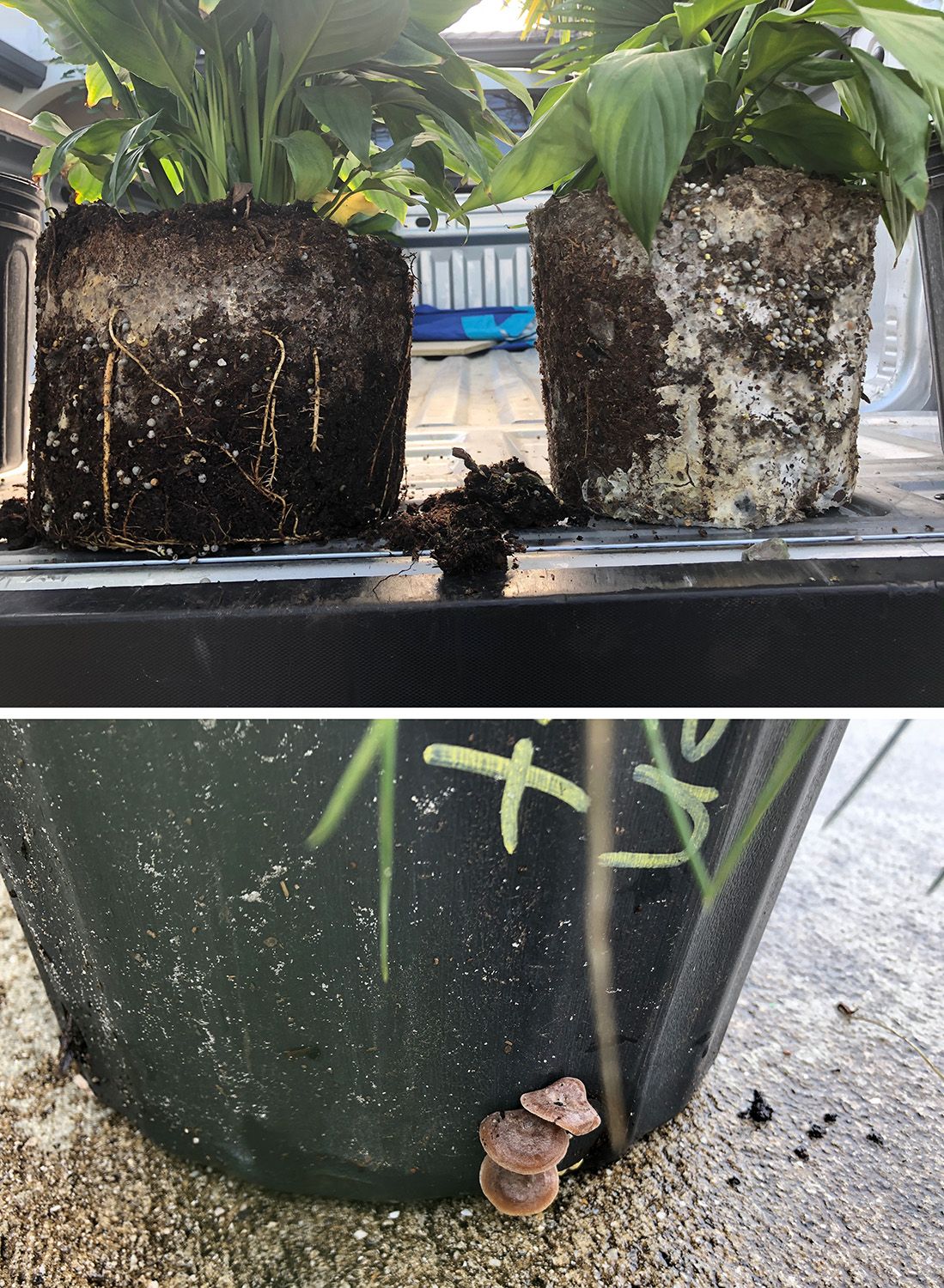
Credit: (Top) Romina Gazis, UF/IFAS and (bottom) Elena Karlsen-Ayala, USDA Forest Service
Guide to Common Fungi
1. Leucocoprinus birnbaumii (The Yellow Dapperling Mushroom)
Leucocoprinus birnbaumii is the most common mushroom on indoor potting soils, but it can also be found in outdoor potting soils. The entire mushroom has a sulfur yellow color and can grow alone or in clusters (Figure 2). The caps of these fungi have an umbo (a raised or protruded center) and vertical striated markings. The stalk of the mushroom is thin and fibrous with a partial veil (a ring around the stalk), and the cap is delicate with a slightly in-rolled margin. Leucocoprinus birnbaumii can produce a dense yellowish-white mycelium on the surface of potting soil. This fungus species also makes small, asexual survival structures in the soil called sclerotia, which is part of why this fungus survives so well in potted plants (Matsuzawa et al. 2011). Immature mushrooms will emerge as yellow stalks with round, bulbous tops before opening into a mushroom cap (Figure 2). These mushrooms can fruit year-round in indoor potting soils and are considered poisonous (Hall et al. 2003).
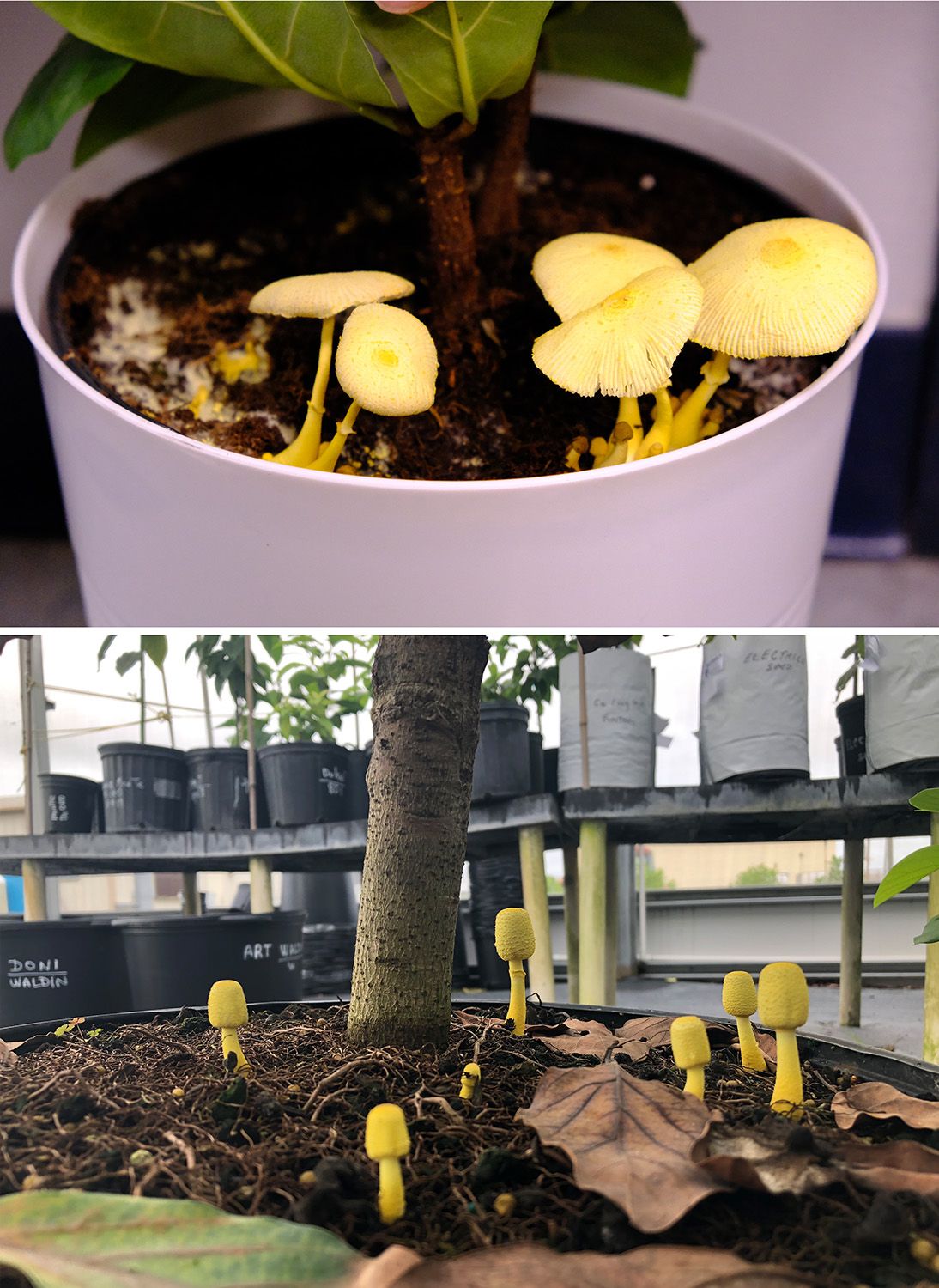
Credit: (Top) Elena Karlsen-Ayala, USDA Forest Service, and (bottom) Romina Gazis, UF/IFAS
2. Bird’s Nest Fungi
Bird’s nest fungi refer to several species of related, cup-shaped fungi in the family Nidulariaceae (Agaricales). Although they are related to typical mushroom-forming fungi, the bird’s nest fungi are unusual because they do not look like “traditional” gilled mushrooms that have a cap and stipe. Instead, these fungi form small “cups” or “nests” (the peridium) that open when mature. Within these small nests, these fungi form their spores inside of small, globose, seed-like structures (peridioles) (Kraisitudomsook and Smith 2021; Kraisitudomsook, Healy, and Smith 2021) (Figure 3). The name “bird’s nest fungi” comes from their resemblance to small nests with eggs in them. The cups are generally brown, grey, white, or yellow on the outside. These fungi spread via rain splash. In many species, the peridioles are attached to the inside of the cup via a thin string called a funicular cord. There is a sticky end of the cord known as the “hapteron” which helps the peridiole attach to a surface after dispersal. Because these fungi get around easily through wind and water and they easily survive heating and drying, they can be quite difficult to manage in the landscape environment (Kraisitudomsook and Smith 2021). They can be a problem in the nursery industry where peridioles attach to the surface of pots or leaves and can only be mechanically removed by hand (Figure 3). Bird’s nest fungi are not pathogenic nor toxic but can make plants unmarketable. Bird’s nest fungi grow in large clusters in mulch or leaf litter, although at least one species can also be found in dung (Kraisitudomsook, Healy, and Smith 2021).
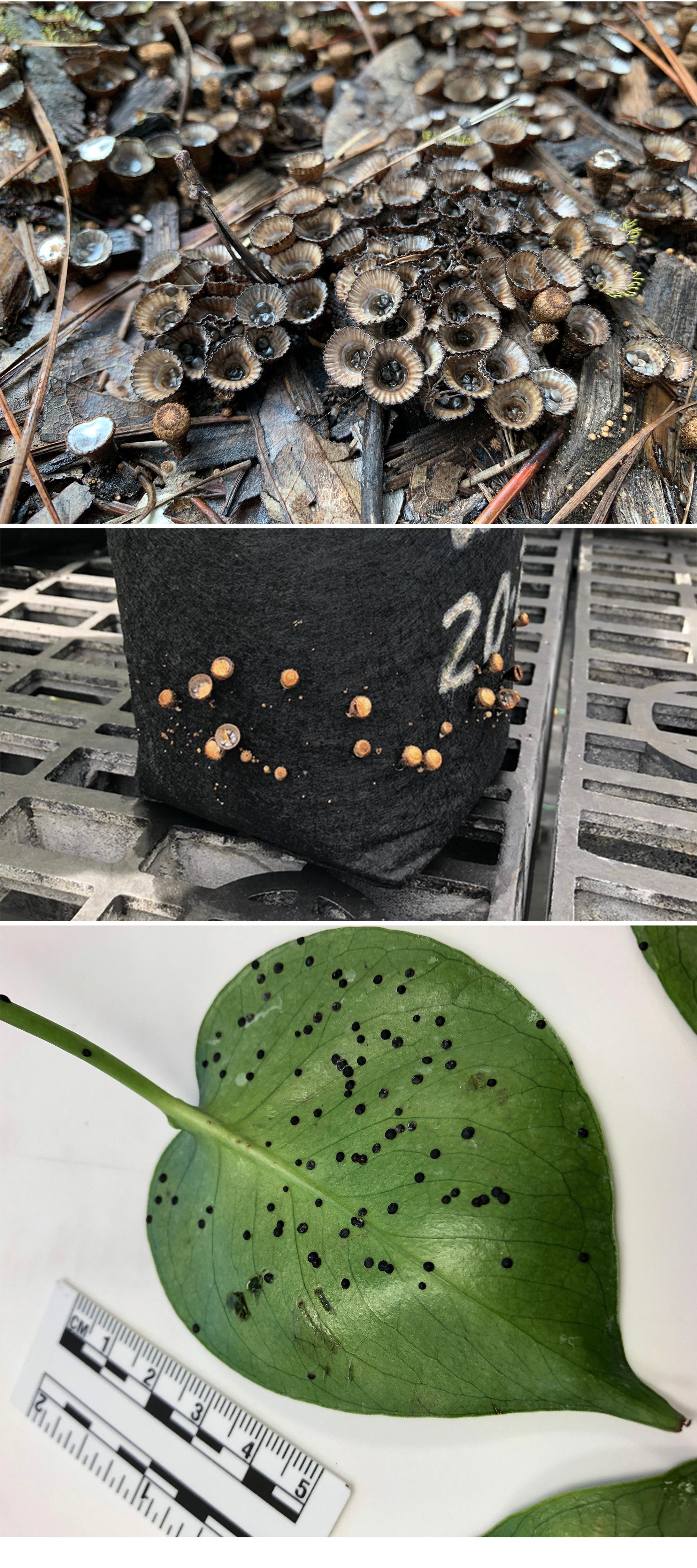
Credit: (Top) Matthew E. Smith, UF/IFAS, (middle) Elena Karlsen-Ayala, USDA Forest Service, and (bottom) Romina Gazis, UF/IFAS
3. Chlorophyllum molybdites (The Green-spored Parasol Mushroom)
Chlorophyllum molybdites is a widely distributed mushroom in the southeastern United States and is especially common and widespread in Florida (Espinoza and Smith 2016; Kimbrough 2000). This mushroom is among the most common mushrooms in Florida lawns but sometimes can also be found in mulch and potting soil, including outdoor potted plants (Figure 4). This species often produces many mushrooms together in one area and is also known for the charismatic “fairy rings,” or large circles of mushrooms, that it produces in lawns (Figure 4). Chlorophyllum molybdites produces large mushrooms that contain a white-to-brown cap with light brown or beige scales (Figure 4). The stalk, attached to a partial veil (ring), is white and measures 10–25.5 cm long and 1–2.5 cm thick (Bessette et al. 2007). The gills are white when young but turn green as the spores mature. This mushroom turns brownish with age and can sometimes stain brownish or brownish red when handled. Chlorophyllum molybdites produces a green spore print, which is an uncommon color for mushroom spores and therefore a useful diagnostic character. This species is a concern because it is poisonous to humans and pets, causing significant gastrointestinal problems when ingested (Espinoza and Smith 2019).
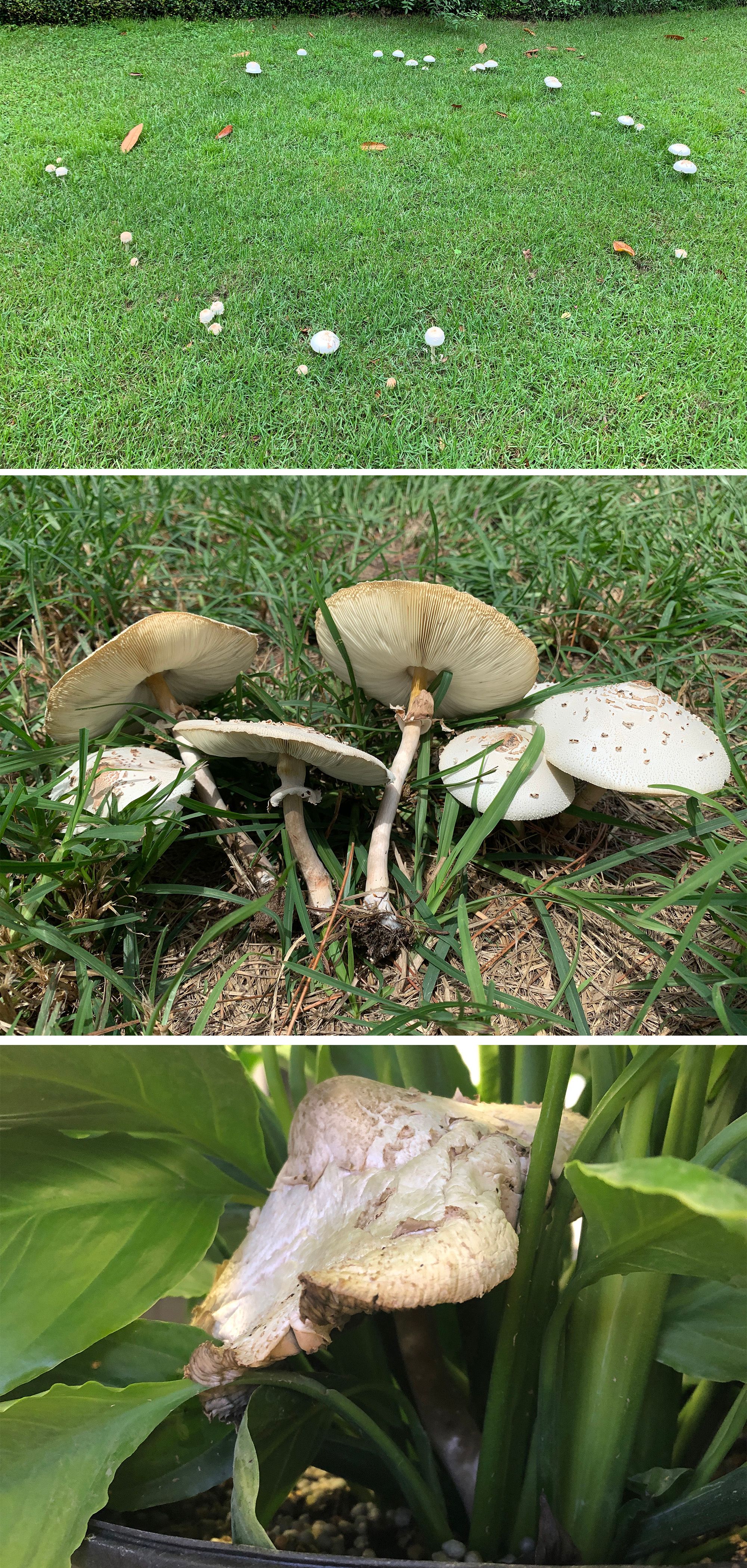
Credit: (Top and middle) Matthew E. Smith, UF/IFAS and (bottom) UF/IFAS Tropical Research and Education Center Plant Diagnostic Clinic
4. Fuligo septica (Dog Vomit Slime Mold)
Fuligo septica, is a common slime mold found in the home landscape, particularly on mulch and in rare occasions in potted nursery plants (Figure 5). Slime molds are not true fungi but often get confused with fungi because of their growth on decaying wood or plant material. Slime molds are different from fungi because they do not cause decay. Instead, slime molds eat bacteria and yeasts that occur on decaying materials. Fuligo septica, commonly referred to as “the dog vomit slime mold,” can be prolific in urban areas with wet mulch. Fuligo septica grows on the bases of trees or on other living vegetation. This slime mold is bright yellow and resembles scrambled eggs when it is fresh. As it ages and starts to mature, it becomes crusty on the outside and powdery on the inside. It also becomes lighter in color during the maturation process, changing from bright yellow to pale yellow, yellow green, or gray. Although Fuligo septica may look a bit strange, it is harmless—this species is not toxic nor pathogenic to humans or pets. There is no need to treat this slime mold or attempt to remove it.
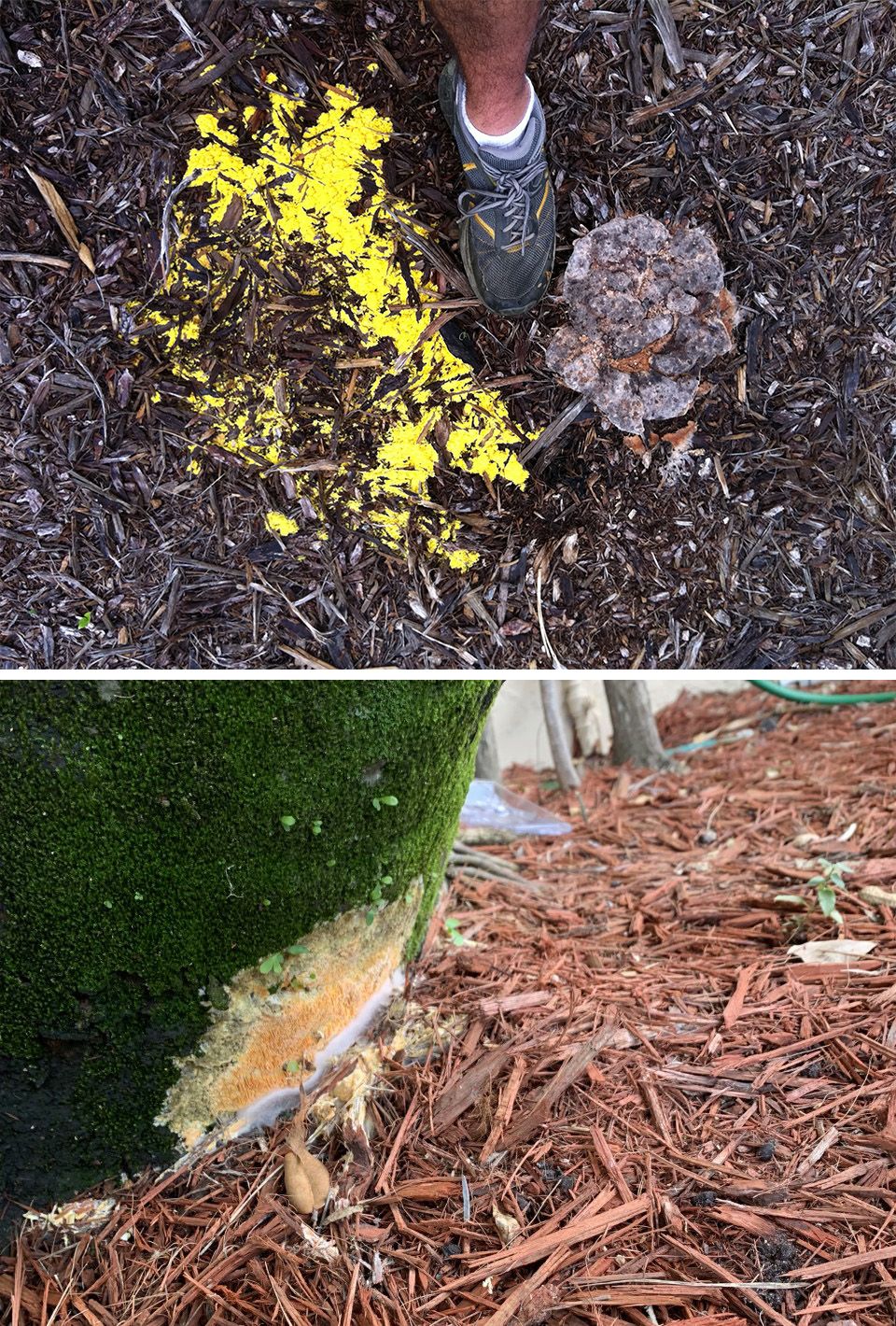
Credit: (Top) Matthew E. Smith, UF/IFAS and (bottom) Romina Gazis, UF/IFAS
5. Geastrum (Earthstars)
Species in the genus Geastrum, often referred to by their common name “earthstars,” are star-shaped fungi that begin completely enclosed when they are immature and open as they mature. The spores of this fungus are contained in an enclosed rounded spore case in the middle with a star-shaped outer peridium (rind) (Figure 6). When earthstars dry out, they shrivel and close. These fungi can disperse their spores in rain splash or wind. The outer peridium is dark brown and may have a cracked appearance when dry. The center spore case is comprised of thin delicate tissue that is typically lighter brown with an opening on top. If the central spore case is compressed, the fungus will release its brown powdery spores. Once spores are released, the spore case might appear deflated. These fungi are not known to be toxic, but they are still inedible.
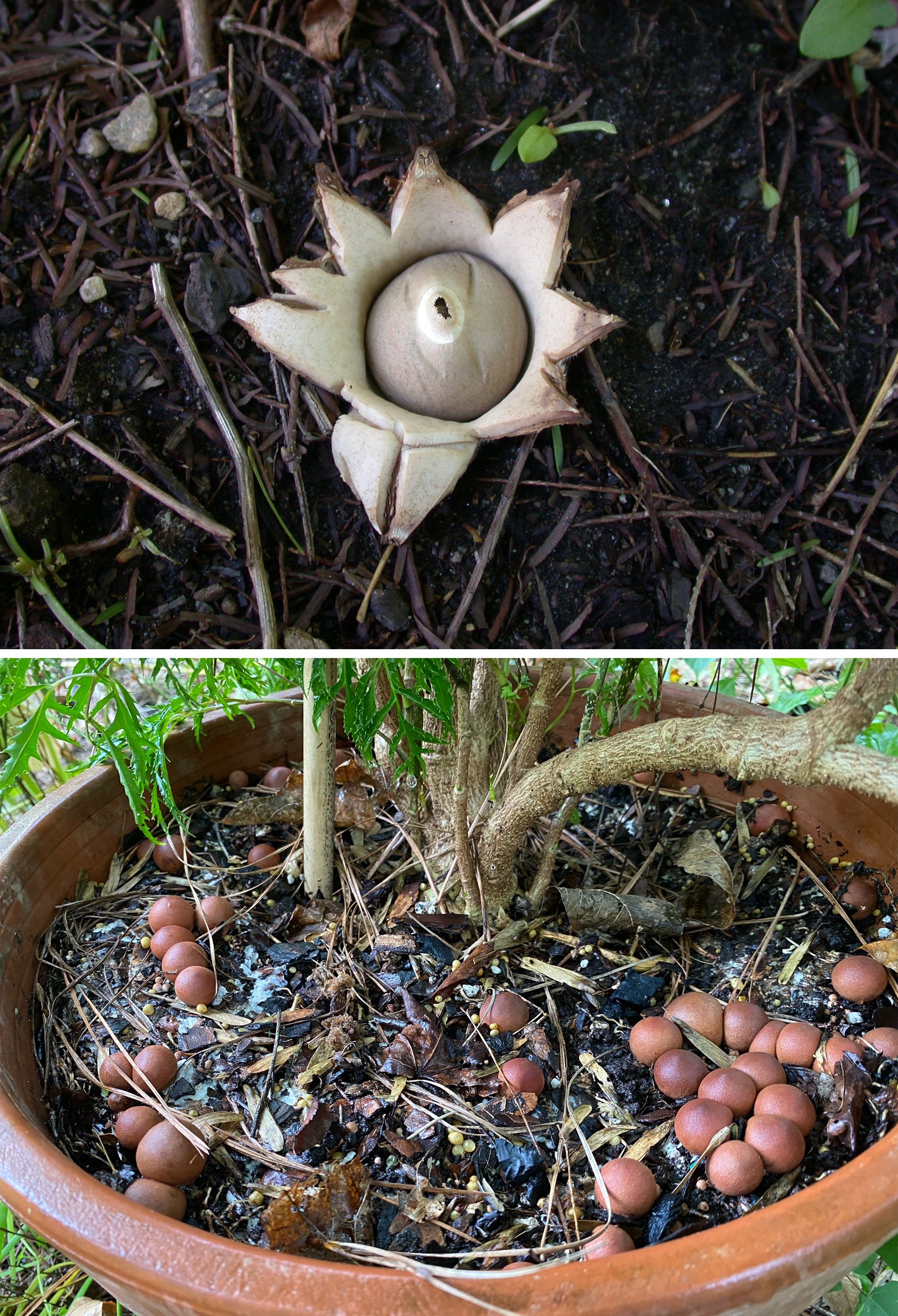
Credit: (Top) Courtesy of Mark S. Elliot, licensed under CC-BY-NC-ND, and (bottom) Photo by R. Healy
6. Asperosporus subterraneus
Asperosporus subterraneus is a sequestrate mushroom, meaning the sporocarp is completely enclosed in a truffle-like shape and fruits below the soil (Figure 7). These truffle-like fruiting bodies are globose to irregular in shape, approximately 5–30 mm in diameter, light tan in color when fresh, and darker brown in color with age (Karlsen-Ayala, Gazis, and Smith 2021). When the fruiting bodies are cut open, they turn bright red to pinkish and have a rancid odor. The peridium is delicate when dry, and the inside of the fruiting body where the spores are produced turns darker brown and becomes more powdery and more delicate when dry. These fungi can produce prolific mycelium that can bind the soil, creating a thick hydrophobic mat (Figure 7). This fungus is not a plant pathogen. However, unlike other mushrooms that fruit above the soil, Asperosporus subterraneus is usually found when the plant is exhibiting symptoms of decline. This plant decline occurs because the thick hydrophobic fungal mat prevents water and nutrients from being absorbed by the plant, not because the fungus causes disease. So far, this fungus has only been found in potted Boston fern plants (Nephrolepsis exaltata) in south Florida, but given that it is a newly described genus, it is possible that this fungus could be found in other potted plants.
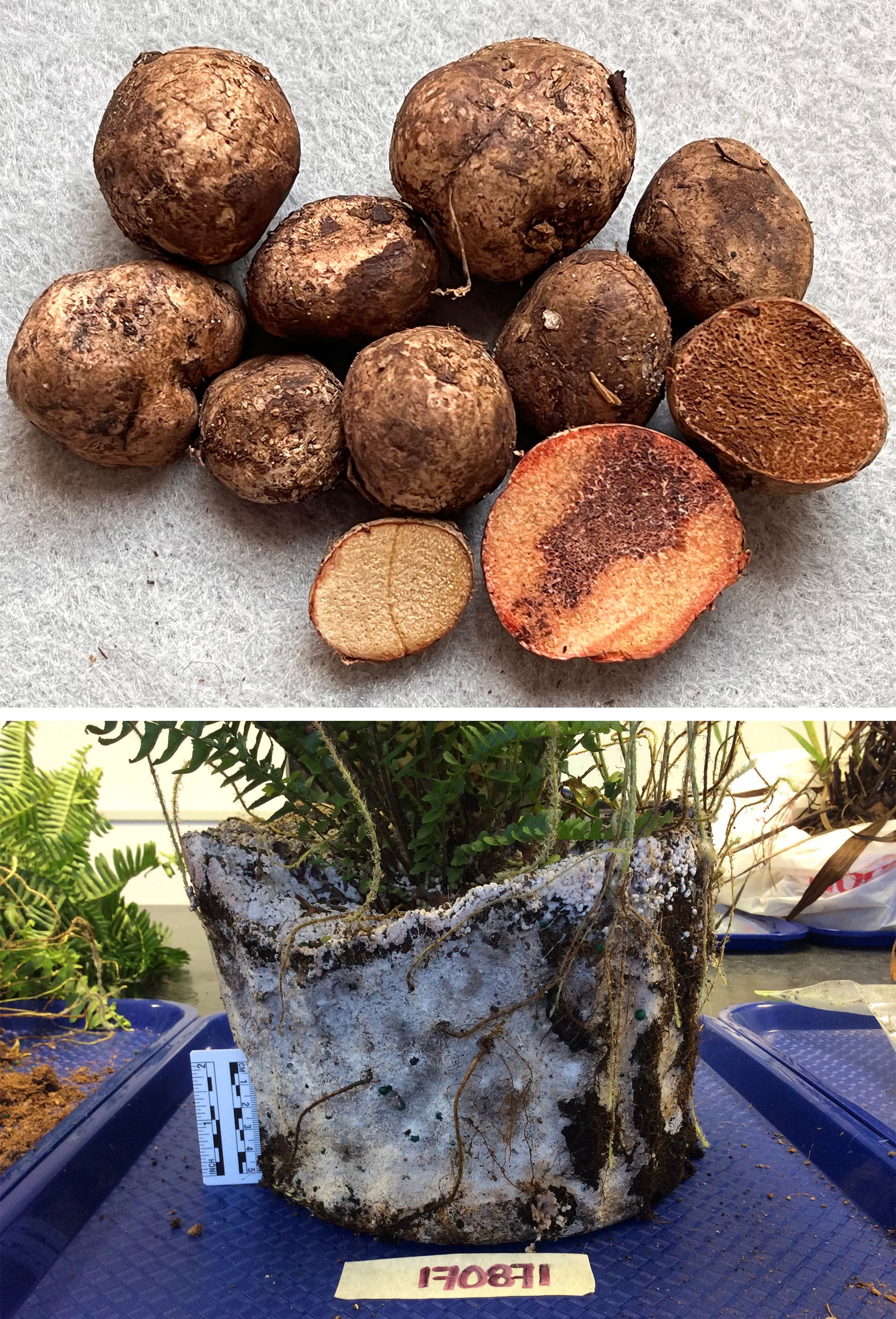
Credit: (Top) Matthew E. Smith, UF/IFAS and (bottom) UF/IFAS Tropical REC Plant Diagnostic Clinic
7. Coprinoid Fungi
Many genera of fungi belong to the coprinoid group, or “Inky Caps,” which includes the genera Coprinus, Coprinopsis, Coprinellus, and Parasola (Redhead et al. 2001). Coprinus species often grow in mulched areas and lawns, and these can sometimes be found in potted plants. These mushrooms begin with off-white, bulbous caps that often look shaggy or scaly and open into cone-shaped caps as they mature (Figure 8). Their caps are approximately 4–10 cm wide, generally larger than other coprinoid fungi. The stalks are white, smooth, and approximately 10–20 mm thick (Bessette 2007). These gilled fungi have off-white, tan, or gray caps; produce black spores; and become deliquescent (i.e., they liquify) when mature (Hopple and Vilgalys 1999). Coprinopsis, Coprinellus, and Parasola fungi can look very similar, but they are generally smaller and more delicate. These genera fruit prolifically in lawns, mulch, dung, and sometimes in potted plants. Coprinopsis species generally have a cap 1–5 cm wide with stalks 4–10 cm long. The caps can be scaly and white when young, but they often become smooth at maturity, then grow darker and start to deliquesce as they age. Coprinellus have caps that are more bell shaped with deeper striated grooves and thinner more delicate stalks. Parasola typically have flatter caps, slightly resembling an open umbrella shape (Figure 8). The caps are small (1–3.5 cm wide) and have a papery texture.
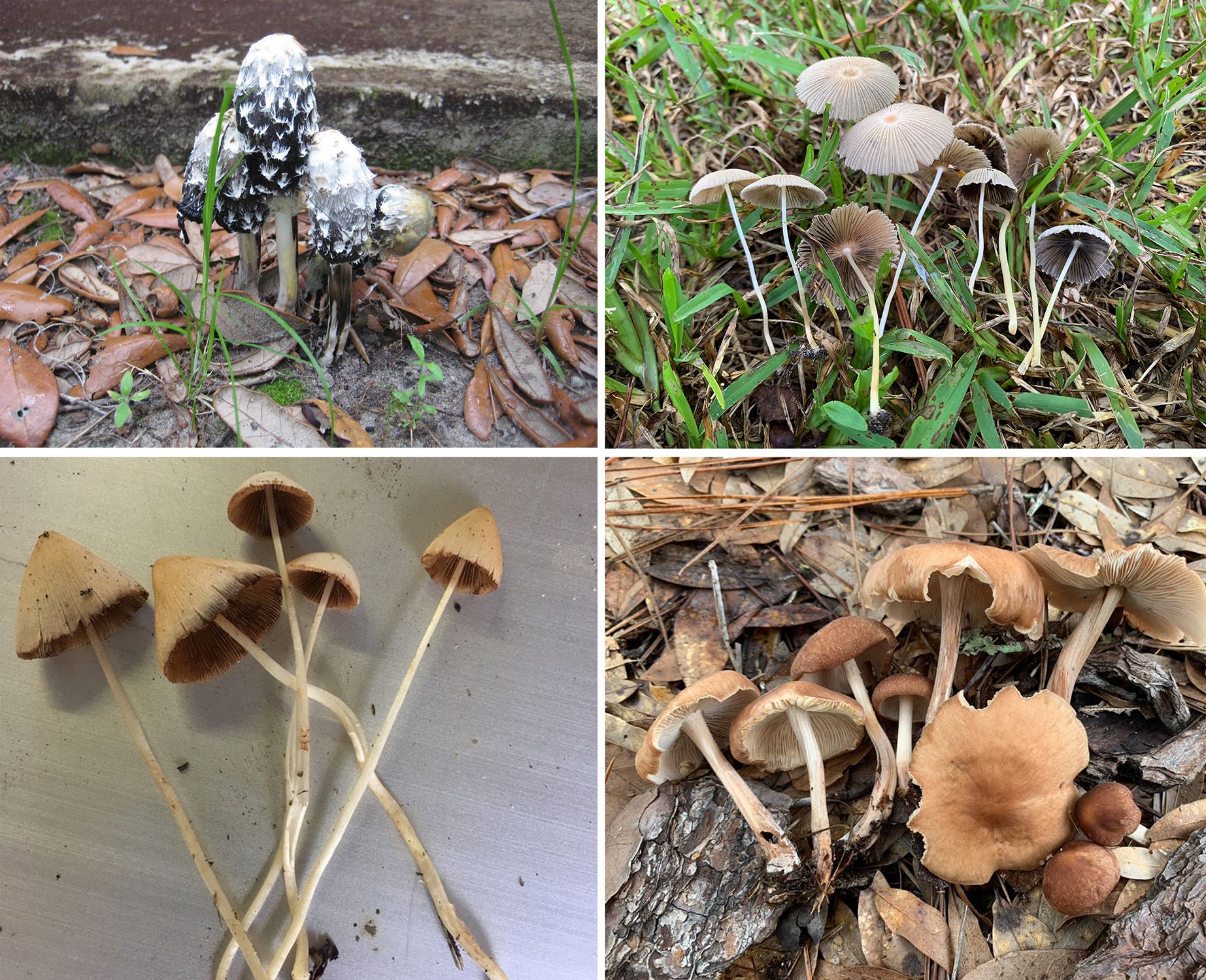
Credit: Matthew E. Smith, UF/IFAS
8. Other Agaricoid Fungi
Many different mushroom species share similar characteristics and grow in similar habitats, making it very difficult to differentiate certain groups of fungi without additional resources such as microscopy or molecular identification. There are many stalked mushrooms with gills that can occasionally be found in potted plants, and most of them are harmless. Two commonly found genera, Lepiota and Conocybe, may raise concern because some species contain amatoxins and are poisonous (Hallen et al. 2003; Angelini et al. 2020). Lepiota species have white spores, and most of them have an obvious ring around the stalk (called an annulus), free gills (the gills do not reach the stalk), and scaly caps (Vellinga 2003). Some of them can stain pink or pinkish red when bruised or handled. Most Lepiota species are small, with caps no more than 10 cm across and stalks typically no taller than 15 cm. Conocybe apala can look similar to inky caps, but they are never deliquescent, and their spores are rusty brown instead of black (Figure 8). Finally, another mushroom that may commonly be found in Florida leaf litter, mulch, and potentially in potting soils is Collybiopsis luxurians (previously called “Collybia luxurians”). This mushroom often grows in clusters, has white spores, a reddish-brown cap, and white gills (Figure 8). When the mushroom is young, the caps may appear more like a button mushroom with rounded incurved margins. As the mushroom ages, the caps flatten out and become irregularly shaped at the edges as the gills may flip upwards onto the cap (Petersen and Hughes 2021).
Management
Fungi need the right environmental conditions to germinate and grow, including temperature, humidity, and moisture. Generally, when mushroom-forming fungi are growing in potting soils it is the result of high humidity, low light, and warm temperatures. Overwatering may encourage fungal growth and stimulate mushroom fruiting. Most mushroom-forming fungi are not pathogens of potted plants. However, overly hot and wet conditions are also conducive to the growth of many fungi and bacteria that can cause plant diseases, such as root and/or stem rots. Reducing overhead irrigation and instead watering plants at the base of the stem can help. When pots are kept indoors, changing the location of the pot to an area with less humidity or a cooler temperature may help to prevent more mushrooms from forming. Mushrooms can be removed from the soil or mulch by picking off the fruiting bodies by hand and throwing them away. Raking the top of the soil can help aerate and dry both the soil and mulch to prevent new mushrooms from forming. If the entire mulch area is highly colonized by fungal mycelium, it should be completely removed, and the soil should be replaced to prevent continued fungal proliferation. Nurseries and homeowners should consult their local county Extension office for management recommendations prior to applying any fungicides or other chemical products. Any application of chemical products should be accompanied by changes in cultural practices.
Toxicity
There is no easy way to determine whether a fungus is toxic just by looking at it. Touching and handling mushrooms is not dangerous. However, you should never ingest any unknown fungi. Fungal fruiting bodies can be picked out of the planter pot and thrown in the trash if there is a concern that pets or young children could ingest them. Some common mushrooms in potting soils can be toxic when consumed, such as Chlorophyllum molybdites, Leucocoprinus birnbaumii, or some species in the genera Conocybe and Lepiota. If there is ever a concern about mushroom poisoning, contact Florida Poison Control (800-222-1222) or Dr. Matthew E. Smith (trufflesmith@ufl.edu, 352-273-2837). When submitting a mushroom to a UF/IFAS Plant Diagnostic Clinic or Extension office for identification, it is important to submit fresh material as soon as the mushroom is picked and include several specimens when possible. Take photos of the substrate the mushroom is growing on (e.g., woodchips, grass, soil) and take close-up photos of the top of the cap, the sides of the mushroom (showing the full stalk), and under the cap of the fruiting body (so the color of the gills can be seen). It is also useful to include an item such as a pen, pencil, or coin in the photo for scale. For more information visit: https://plantpath.ifas.ufl.edu/extension/mushrooms/services/.
References
Angelini, C., A. Vizzini, A. Justo, A. Bizzi, P. Davoli, and E. Kaya. 2020. “First Report of a Neotropical Agaric (Lepiota spiculata, Agaricales, Basidiomycota) Containing Lethal α-amanitin at Toxicologically Relevant Levels.” Frontiers in Microbiology 11: 1833. http://doi.org/10.3389/fmicb.2020.01833
Bessette, A. E., W. C. Roody, A. R. Bessette, and D. L. Dunaway. 2007. Mushrooms of the Southeastern United States. Syracuse, NY: Syracuse University Press.
Espinoza, L., and M. E. Smith. 2019. “The Green-Spore Poison Parasol Mushroom, Chlorophyllum molybites.” PP324. Gainesville: University of Florida Institute of Food and Agricultural Science. https://edis.ifas.ufl.edu/publication/PP324
Hall, I. R., S. C. Stephenson, P. K. Buchanan, W. Yun, and A. L. J. Cole. 2003. Edible and Poisonous Mushrooms of the World. Cambridge, UK: Timber Press.
Hallen, H. E., R. Watling, and G. C. Adams. 2003. “Taxonomy and Toxicity of Conocybe lactea and Related Species.” Mycological Research 107 (8): 969–979. http://doi.org/10.1017/S0953756203008190
Hopple Jr., J. S., and R. Vilgalys. 1999. “Phylogenetic Relationships in the Mushroom Genus Coprinus and Dark-spored Allies Based on Sequence Data from the Nuclear Gene Coding for the Large Ribosomal Subunit RNA: Divergent Domains, Outgroups, and Monophyly.” Molecular Phylogenetics and Evolution 13 (1): 1–19. http://doi.org/10.1006/mpev.1999.0634
Karlsen-Ayala, E., R. Gazis, and M. E. Smith. 2021. “Asperosporus subterraneus, a New Genus and Species of Sequestrate Agaricaceae Found in Florida Nursery Production.” Fungal Systematics and Evolution 8 (1): 91–100. https://doi.org/10.3114/fuse.2021.08.08
Kimbrough, J. W. 2000. Common Florida Mushrooms. University of Florida, Extension Institute of Food and Agricultural Sciences.
Kraisitudomsook, N., and M. E. Smith. 2021. “Bird’s Nest Fungi: Charismatic Mushrooms in Your Garden: PP361, 12/2020.” EDIS 2021 (1): 3. https://doi.org/10.32473/edis-pp361-2020
Kraisitudomsook, N., R. A. Healy, and M. E. Smith. 2021. “Molecular Systematics and Taxonomic Overview of the Bird's Nest Fungi (Nidulariaceae).” Fungal Biology 125 (9): 693–703. https://doi.org/10.1016/j.funbio.2021.04.003
Martínez-Espinoza, A. D., M. Pearce, and L. L. Burpee. 2009. “Turfgrass Diseases in Georgia: Identification and Control.” Bulletin 1233. Athens, GA: University of Georgia Cooperative Extension. https://extension.uga.edu/publications/detail.html?number=B1233&title=turfgrass-diseases-in-georgia-identification-and-control
Matsuzawa, T., Y. Horie, T. Yaguchi, Y. Sakamoto, and T. Fukiharu. 2011. “Economic Damage to Cyclamen Growth by Sclerotia of Leucocoprinus birnbaumii.” Japanese Journal of Mycology 52 (1): 38–42. https://www.jstage.jst.go.jp/article/jjom/52/1/52_jjom.H22-05/_article/-char/en
Petersen, R., and K. W. Hughes. 2021. “Collybiopsis and Its Type Species, Co. ramealis.” Mycotaxon 136 (2): 263–349. http://doi.org/10.5248/136.263
Redhead, S. A., R. Vilgalys, J. M. Moncalvo, J. Johnson, and J. S. Hopple Jr. 2001. “Coprinus Pers. and the Disposition of Coprinus Species sensu lato.” Taxon 50 (1): 203–241. https://www.jstor.org/stable/1224525
Vellinga, E. C. 2003. “Phylogeny of Lepiota (Agaricaceae)—Evidence from nrITS and nrLSU Sequences.” Mycological Progress 2: 305–322. https://doi.org/10.1007/s11557-006-0068-x